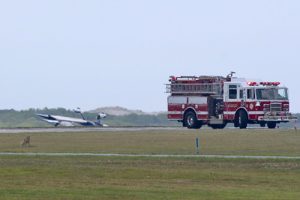
WEST OCEAN CITY — The small plane that skidded off the runway and overturned at the Ocean City airport last July experienced a dramatic drop in engine revolutions per minute just before the crash, according to a final report released last week.
The National Transportation Safety Board (NTSB) report found shortly before noon on July 19 an experimental, amateur-built Vans RV-7A took off from the Ocean City Airport bound for Manassas, Va., according to the flight plan filed for the aircraft.
According to the NTSB’s final report, the unidentified pilot performed a pre-flight inspection of the aircraft and an engine run-up with no anomalies reported. The pilot then taxied the aircraft onto runway 20 and applied full power as he took off. However, with the plane about 500 feet off the ground, the engine experienced a complete loss of power and dramatic reduction in revolutions per minute (RPMs), according to the report.
“The flight data indicated that the RPM increased to about 2,600 around eight minutes and 15 seconds into the recording,” the report reads. “Then, about 450 feet in the air and eight minutes and 30 seconds into the recording, the tachometer decreased to about 1,500 RPM and maintained that over the next minute and 12 seconds until the engine power reduced to about 800 RPM and finally zero RPM.”
The pilot verified the throttle, mixture and propeller were in the full forward position and elected to stay in the airport traffic pattern and attempt a landing on runway 14. According to the NTSB report, the pilot radioed the tower that he was landing on runway 14. However, on approach he noticed another airplane was already on the runway preparing for a departure, according to the report.
The pilot then radioed the pilot of the other aircraft and asked him to abort the takeoff. As that airplane exited the runway, the pilot of the distressed aircraft continued to approach runway 14. The pilot reported his aircraft was “high and fast,” but he still wanted to land on the runway in order to avoid landing in the water, according to the report.
The pilot landed the plane “hard” about 1,000 feet from the end of the runway and continued for about another 150 feet into the grass where it “nosed over” and came to rest inverted, which resulted in substantial damage to the rudder. The pilot sustained minor injuries and was transported to the hospital. A Federal Aviation Administration inspection revealed compression was confirmed on all cylinders, fuel was noted in the fuel lines and there were no holes in the crankcase.

